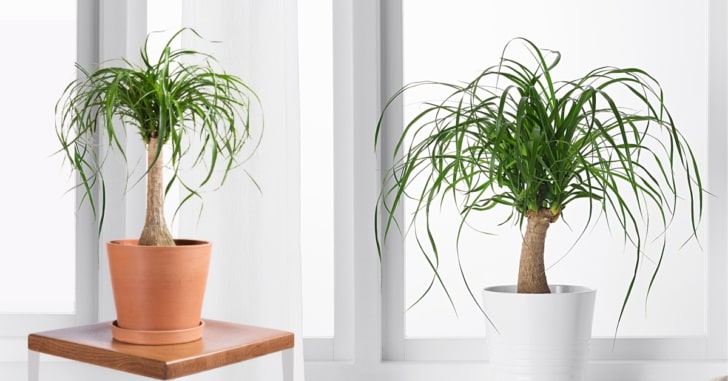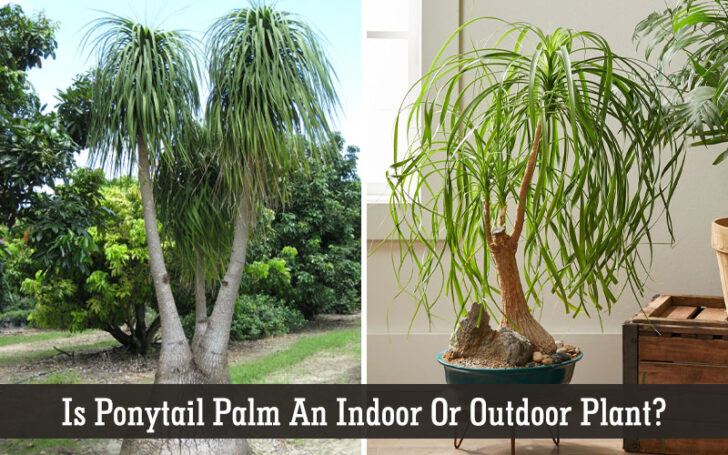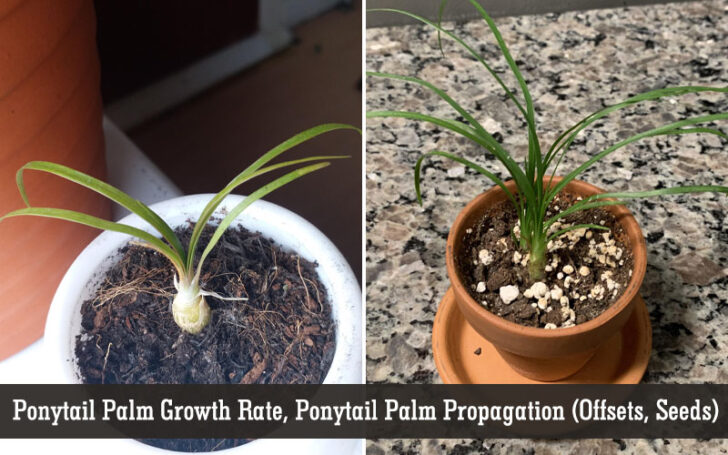Garden
Ponytail Palm Care – The All-Inclusive Precise Guide You Needed Badly
The best thing about our ponytail palm care guide? It’s very easy to follow.
It would not be wrong to say that the ponytail palm is an ideal houseplant like peperomia, which grows on its own with some care. (Yes, not an attention seeker)
But the point to consider is
Is ponytail palm tree care difficult? (Ponytail Palm Care)
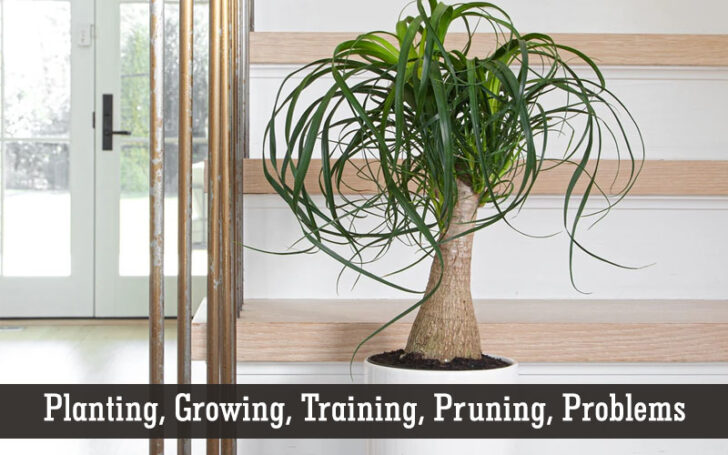
Want to know how to do this the easy way? You just need to follow a few tips and instructions and it’s getting off to a good start for its evergreen life. (Well, if you follow our guide)
Fun fact: The ponytail palm tree is like that popular kid in the family who gets a new name every time. So, people like elephant plant, pony palm trees, etc.
Table of Contents
Is Ponytail Palm an Indoor or Outdoor Plant?
Before we get you started on ponytail palm care, let’s clear up your confusion: Indoor or outdoor? (Ponytail Palm Care)
Is ponytail palm an indoor or outdoor plant?
It is best to grow outdoors and can thrive indoors perfectly. All you have to do is prepare a fast-draining, hydrated soil mix to prevent root rot and control watering habits.
Honestly, if we have to say it, it’s versatile. (Ponytail Palm Care)
| Features | Outdoor | Indoor |
| Soil | Well-Drained (Loamy & Sandy)Mixed-Soil (Cactus & Soil-Mix) | Potting Mix (Succulent and Cacti) DIY (Equal parts of potting soil, perlite, and sand) |
| Temperature | 45°F – 70°F | Normal Room Temperature (60°-80°) |
| Watering | Once in 3-4 Weeks (Or less; feel the dryness of the soil) | Once in 2-3 Weeks (Don’t Overwater) |
| Light | Full Sun (8 hours) | Indirect Light (4-6 hours) |
| Weather | Summer | Winter (Best to avoid freezing temperatures) |
| Flowers | Takes Time (>5 years) | Very Rare (Once in a blue moon) |
| Tree Length | 20ft – 30ft | 3ft – 9ft |
How to care for ponytail palm?
It grows best in semi-dry conditions, loves indirect bright light and is not a fan of humidity. The ideal watering requirement is once every 2-3 weeks. Allow the top two inches of soil to dry before rewatering.
Get all the information here to do justice to the beauty and growth of your ponytail bonsai. (Ponytail Palm Care)
1. Planting
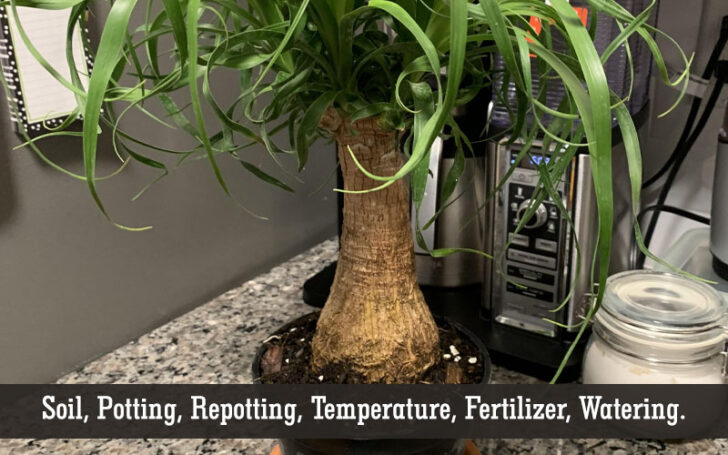
i. Soil
Best soil for ponytail palm?
Heavy soil is a big no-no! Opt for a well-drained soil mix often used for succulents and cacti. Make your own potting soil mix by combining equal parts of potting soil, perlite, and sand. (Ponytail Palm Care)
ii. Potting
You just bought a beautiful ponytail palm plant from the store and marvel at the soothing air it brings to your interior. And a thought crossed his mind, (Ponytail Palm Care)
How can you store the plant yourself?
Since ponytail palms don’t like wet soil, get a clay-based pot (2 inches wider than the base of the plant) with a bottom hole for easy drainage of excess water. Put the potting soil mix in and place your baby palm in it. (Ponytail Palm Care)
And that’s it. Yes really!
Remember to keep the lower stem above the ground.
Opt for a small sized heavy pot as these plants like to get crowded in their growing areas. Trust us when we say that these slow-growing plants can become giants as they grow. (Ponytail Palm Care)
iii. Temperature
What is the best indoor grooming temperature for my ponytail palm? If you have this beautiful plant around, you must have thought about it once.
Yes, it can survive in average indoor temperature. Can be considered cold hardy (mature plant) if not placed for extended periods in low (15°F) environments. Ideal Temperature: 45°F – 70°F. Hardiness Zone: 9-12. (Ponytail Palm Care)
Tip: Do not leave near fences, vents or windows, as freezing temperatures in winter can damage the plant.
iv. Watering
The primary problem with ponytail palm watering is that people don’t know:
When is it overwatered? When is it watered?
So how do you know when to water a palm plant?
‘Check the soil!’ If the soil feels dry to the root of the plant, that’s a sign that you need to water it right away. However, if there is some wetness, let it dry. Ideal watering time: once every 2-3 weeks.
Take advantage of the doubt, because you don’t want to over-water or over-water it. Your beautiful plant can survive for weeks without water. Yes, you could say they have dry feelings towards water. (Ponytail Palm Care)
v. Fertilizer
What is the perfect time to fertilize?
season of magic; Spring.
You can choose organic chemical or liquid fertilizer to feed your ponytail palm plant. Dilute to ½ strength whichever you prefer.
How often should you fertilize your bonsai?
Liquid or chemical fertilizer (1/2 diluted), whichever you choose, it is best to fertilize once a month during the winter and twice a month during the growing season. (Literally, they are not foodies at all) (Ponytail Palm Care)
vi. Repotting
This forgiving plant is low maintenance (less potted). Cut off larger and damaged roots. Store the potting mix in a new container filled with sand, perlite, vermiculite, and chopped bark. Size: enlarge the flower pot, enlarge the size of the plant.
Repotting a baby ponytail is a little different from a large ponytail pad.
And if you’re dealing with an oversized plant, this can be quite a challenge. (Ponytail Palm Care)
You don’t want to tire yourself before the job is done. What to do then? How is it cooled? Get yourself a wearable cooling fan to finish what you started.
Now that it’s ready. Let’s get it. (yes, it’s the sound of ponytail excited for its new home) (Ponytail Palm Care)
Replanting a small ponytail palm tree is not rocket science. All you need is:
- A clutter-free garden mat (to put the soil)
- The pot is an inch or two larger than the current one (if you want a larger size)
- Or same size flower pot (if you want smaller size)
- And of course the plant
The requirements are similar for a large plant, but extra care must be taken as they are heavy and difficult to deal with. (Ponytail Palm Care)
Note: It can go 2-3 years without repotting, making it one of the best indoor palm plants.
2. Growing
i. Speed of Growth
If you want a rich plant, put it in a potting soil mix and let it grow independently.
It can grow 10-12 inches per year or double after five years. However, the ponytail palm growth rate is much lower indoors (yes, the tortoise is slow). Growth rate: 12-18ft tall and can spread up to 10-15ft. (Ponytail Palm Care)
ii. Propagation of Ponytail Palm
The evergreen can reproduce by seeds, sister plants, offspring, or shoots.
Propagating new plants from existing plants is as easy as it sounds. (No? Trust us. It really is!)
Get a fast-draining pot or pot and fill it with sand-based or cactus-mix potting soil. Put the rooted end in the soil medium and cover with a plastic bag. Finally, place it in a warm place with moderate light. (Ponytail Palm Care)
Grow from offsets or pups:
- Carefully remove the base of the fry (ideally 4 inches) from the parent plant.
- Place the shoot or fry in a pot of soil mix embankment.
- Cover the pot with plastic wrap.
- Place at normal indoor temperature.
Tip: Do not keep the plant underwater. Mist the soil every few days initially.
Grow from Seeds:
- There are times when offsets do not take root and make seed propagation the only way.
- Seeds may germinate quickly if the coating softens slightly (or if soaked overnight).
- Plant the seeds in a pot (3 inches) filled with sandy soil.
- Mist the soil and cover it with some sand.
- Cover the pot with plastic wrap.
- Place container at warm temperature (at least 68°F).
Tip: Every day, remove the plastic bag and let the soil dry.
3. Care / Training
The ponytail palm is a one-stemmed plant, which means you need to train your plant to maintain the greenness and beauty of the leaf. (Ponytail Palm Care)
i. Trimming
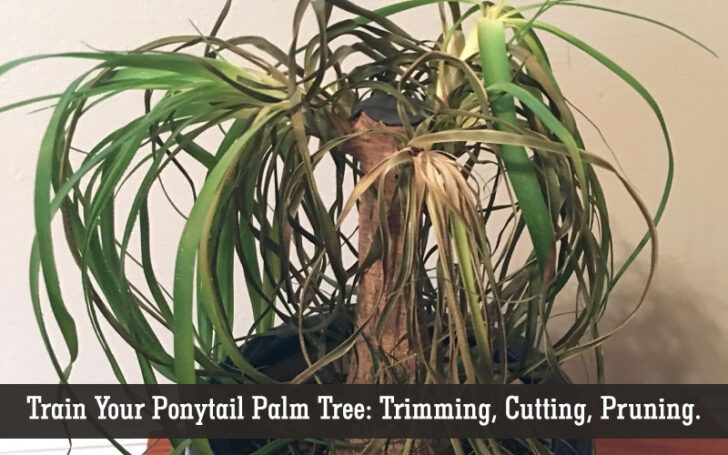
Find wilted, brown, or yellow leaves. Use clean shears or shears to trim and preserve the plant’s beauty. It will allow the plant leaves to grow downward. Ideal time to train: Spring or Early Fall. (Ponytail Palm Care)
ii. Cutting
Should you cut off dead leaves? Yeah! It means removing the affected leaves or dark tips as they are sensitive. Keep eye level with the plant because you don’t want to close your eyes and cut off the wrong part (healthy leaves). (Ponytail Palm Care)
iii. Pruning
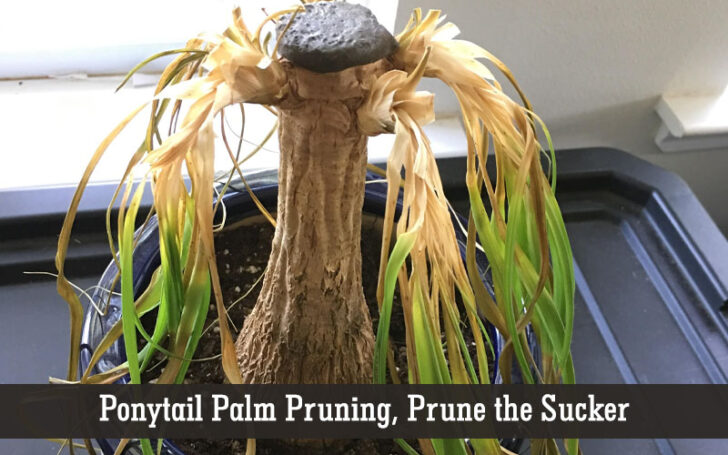
Remove woody material to restore or rejuvenate the plant. Use easy-to-prune secateurs to trim damaged leaves (brown, wilted) like a pro. The best time to prune is fall and the growing season. (Ponytail Palm Care)
Prune The Sucker
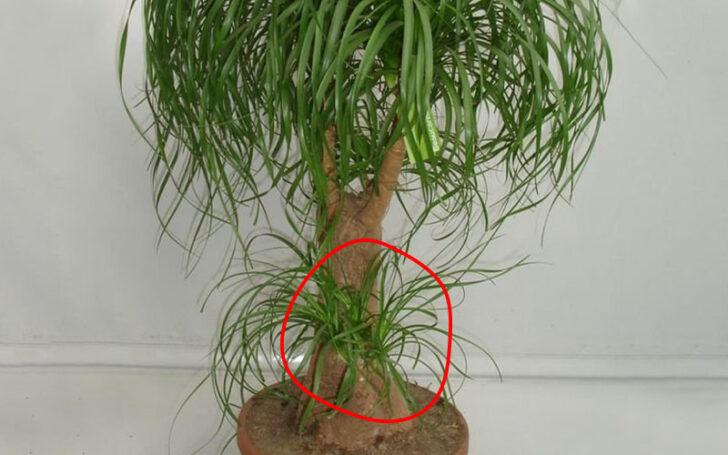
- Suckers or lower plants grow together with the main stem of the parent plant
- They must be removed and grown separately. Otherwise, it gives the base a lump-free look.
- You can carve cutouts (concave) at the base of the stem (main stem).
- Cut the sucker from the main palm, plant it in the soil mix and let it grow. (Ponytail Palm Care)
Note: Place the hollowed-out plant in a relatively dry environment. (to protect the cutting from rotting)
4. Problems
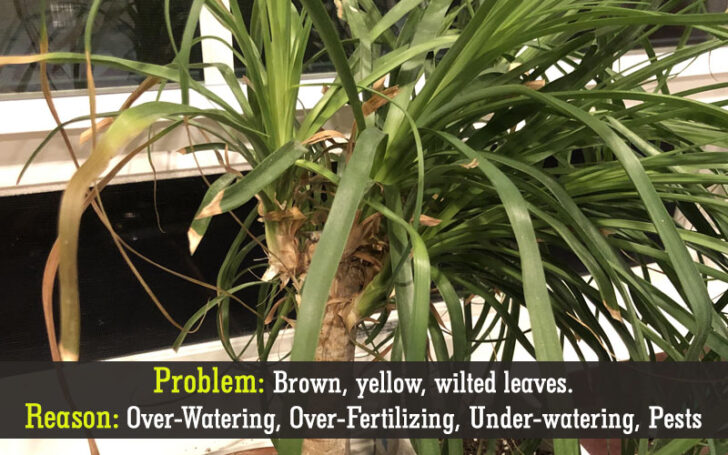
Almost all ponytail palm problems, such as brown, yellow, wilted or dying leaves, are the effects of overwatering the plant. Other causes may be pests, insufficient watering and over-fertilization.
Do not overwater the plant or you will end up with yellow leaves. Similarly, insufficient watering will leave crispy brown leaves. Remember to allow the soil to dry out between watering sessions. (Ponytail Palm Care)
Here are the problems and their solutions.
- The leaves of my ponytail palm are turning yellow
- The base of my ponytail palm is soft and mushy
- The leaves of palm horsetails are brown with pale tips.
Reason?
- The yellow leaves, soft and mushy plant base, and brown and wilted tips of the ponytail palm leaves are mainly due to Overwatering.
Solution?
- Stop watering your plant. Since it is watery, it can go for weeks without water. Allow the soil to dry between watering sessions. (every 2-3 weeks is enough for your plant)
- Help! Tips of my ponytail bonsai are turning brown
Reason?
- If the leaves of your ponytail palm are finally starting to turn brown, it may be due to insufficient watering or over-fertilization. (Ponytail Palm Care)
Solution?
- Brown tips on the leaves of the ponytail palm indicate that it is over-fertilized. Best time to fertilize in Summer and Spring: every 2-3 weeks. Winter and Autumn: Every 4-6 weeks. Usually every 3-4 weeks.
- How do you know if the tree is underwater?
- Why does my ponytail palm have brown leaves?
Reason?
- The ponytail palm plant likes to be in (mostly) dry conditions. So, if you observe dry leaves, shriveled base, depleted roots, or brown leaves, this is clearly a sign that you are overwatering. (Ponytail Palm Care)
Solution?
- Check the soil, stick your finger in the mix, and if it’s sticking to your hand, there’s no need to water it. Allow the soil (2-3 inches) to dry out between watering sessions. (Ponytail Palm Care)
- What’s wrong with my ponytail palm?
- What is the waxy white stuff on my plant?
- How do I treat a Scale on my ponytail palm plant?
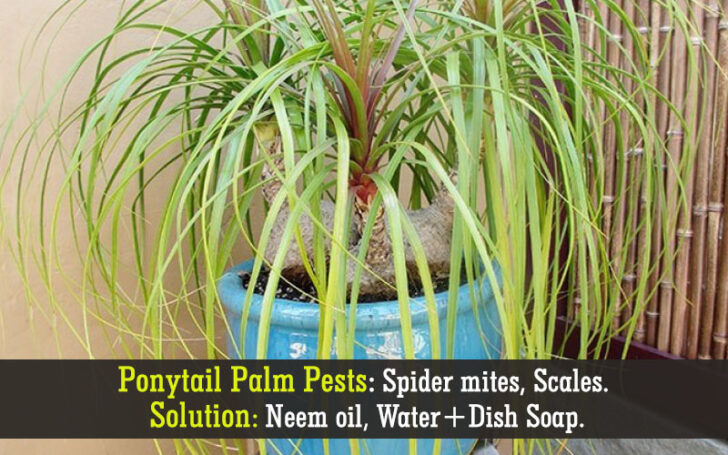
Scale and spider mites are the main pests that infest ponytail palms. Neem oil or a solution of water and dish soap can help get rid of both.
How to identify spider mites? How do you know if the plant is under attack?
Small brown or red dots on leaves or twigs are identified as mites. Black or brown tubers (white waxy bark) indicate scales: yellow leaves and spider webs at the tips indicate that the plant is under pest attack.
Solution?
- spray neem oil
- Scrub with warm water and dish soap
Bottom Line
A slow-growing, low-maintenance, semi-dry environment plant, the horsetail palm is best for people who love greenery but don’t want to put too much effort into it.
You will join us. The pony palm tree is the ultimate houseplant for people of the modern age. (You got it right, the ‘always busy’ group)
This amazing and cute plant is usually simple to care for; The most common challenge one can face is to break the usual “water every day” habit and adapt to their “water every few weeks” needs!
That’s it for us, fellow gardeners!
Did we miss something?
Either way, let us know what new thing you learned from our guide.
Also, don’t forget to pin/bookmark and visit our blog for more interesting but original information.

